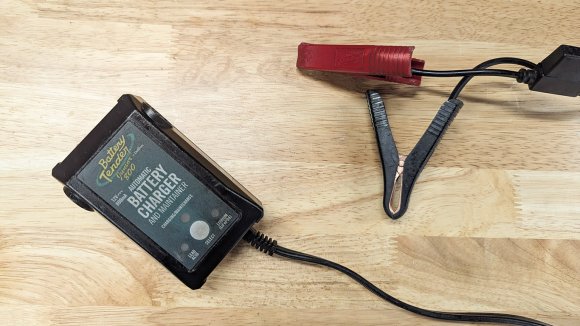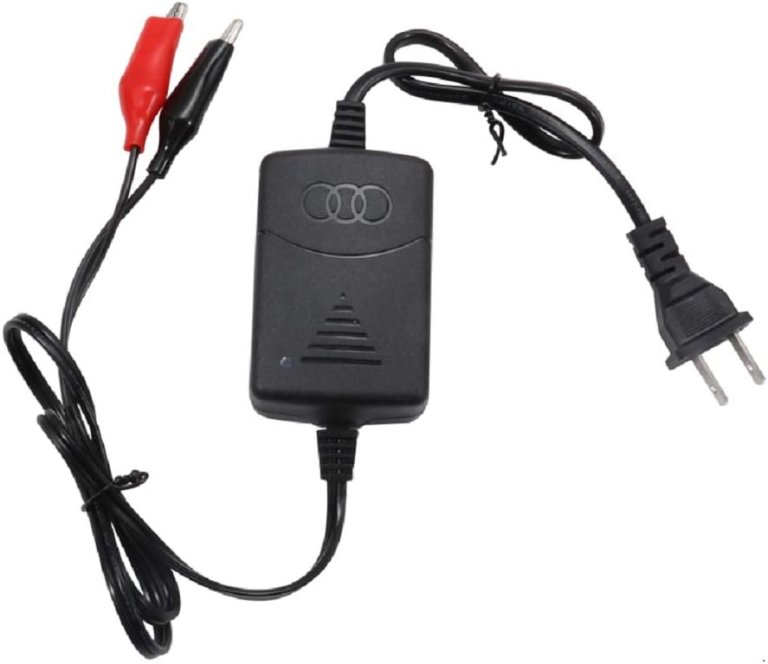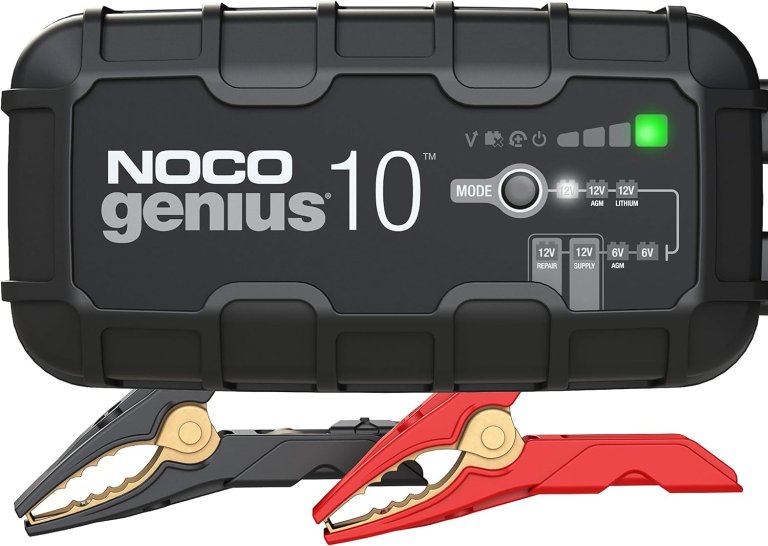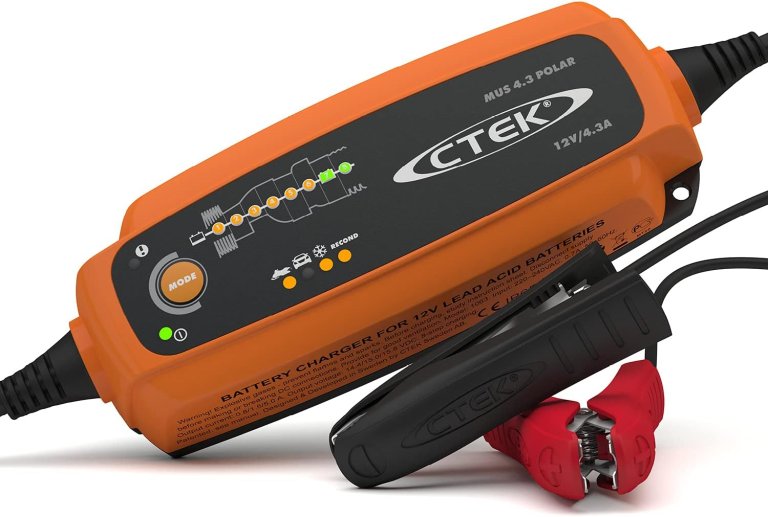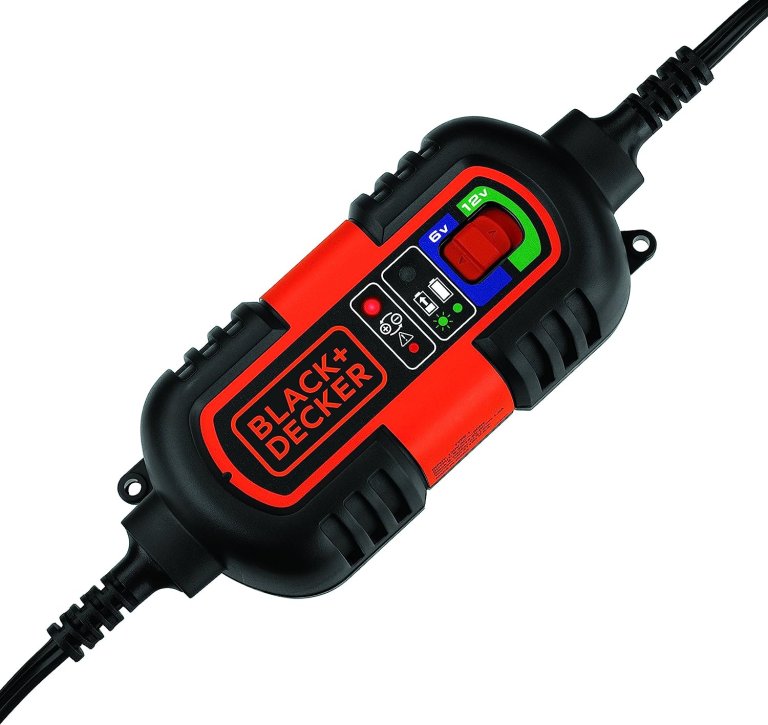We may earn revenue from the products available on this page and participate in affiliate programs. Learn more ›

There are few things as frustrating as a dead battery in your car, ATV, dirt bike, or UTV when you’re ready to take it for a spin. This is when you wish you had just bit the bullet and bought that trickle charger you’ve been eyeing. Trust us, it’s worth it as a trickle charger hooks up to your idle battery and keeps it properly juiced up even sitting for a long time. It’s perfect for any sort of storage situation and to help you find the trickle charger to suit your needs, I sorted through the plethora of options. Take a gander below.
Summary List
- Best Overall: Battery Tender 12-Volt Junior Automatic Battery Charger
- Best Value: Beikalone 12V Sealed Lead Acid Battery Charger
- Best Premium: Noco Genius10 10-Amp Fully Automatic Smart Charger
- Best For ATVs: Battery Tender Plus Charger and Maintainer
- Best Dual-Use: Noco Genius GENM2 Battery Charger
- Best Heavy Duty: CTek Battery Charger MUS 4.3 Polar
- Most User Friendly: Black and Decker 6V, 12V Battery Charger/Maintainer
Our Methodology
When it comes to choosing a reliable and high-quality trickle charger, the options are vast and varied. In order to narrow the playing field, I look at name brands that most people are already familiar with. These companies have a solid track record of providing reliable, comfortable, and high-quality products. I wanted to provide a variety of prices so that there would be a good option to suit any budget. I also tried to include only those options that are super straightforward and easy to use, thus minimizing your chance for error and damage to your battery or yourself. For more about our selection criteria and methodology, check out The Drive’s Gear About page.
Best Trickle Chargers: Reviews & Recommendations
Best Overall: Battery Tender Junior 800
Pros
- Reversed polarity protection
- Can be used on almost any vehicle
- Backed by a five-year warranty
Cons
- Not suitable for AWG batteries
- Not wear-resistant
- Not for fast charging
The Battery Tender Junior 800 a 0.8-amp charger that maintains the health of the battery in your motorcycle, car, or any other off-road vehicle. The charger has a microcontroller that maintains the correct level of power, and its ISM-adaptive charging system quickly adapts to the needs of your battery. In addition, it has reverse polarity protection, meaning that it won’t charge your battery unless it’s connected correctly. The charger has a four-step charging program that entails initialization, bulk charging mode, absorption mode, and float (trickle) mode.
Once it fully charges the battery, it automatically switches to float mode to top off the electrical charge that’s naturally lost with time. The charger is lightweight, easy to use, and backed by a five-year warranty. However, it has been noted that this charger isn’t intended for fast charging, and it’s not wear-resistant. It only has a 12-foot-long connection cable, which is short in comparison to other trickle chargers. The charger is suitable for all gel, lead-acid, and 12-volt AGM batteries, but it doesn’t work on AWG batteries. Commerce editor Hank O’Hop has been using it for years and wrote a full-length review for those interested in learning more about it.
Best Value: Beikalone 12V Sealed Lead Acid Battery Charger
Pros
- Short-circuit protection
- Overcharge protection
- Super affordable
Cons
- May interfere with your radio
- Takes too long to charge large batteries
The Beikalone Sealed Lead Acid Battery Charger is an affordable car battery charger and maintainer with a simple design. It’s fully automatic and suitable for 12-volt lead-acid batteries, AGM, and gel-cell batteries. The unit has a microprocessor-controlled program that monitors the charging process of the battery and maintains the battery at its optimum capacity and automatically stops charging the battery when it’s full. The charger is safe for float charging, as it features spark-free technology and is protected from short circuits, overcharging, and reverse polarity.
The charger is suitable for cars, trucks, motorcycles, RVs, boats, and lawnmowers, and the manufacturer offers a five-year warranty on the product and a full money-back guarantee. One disadvantage of the product is that it may interfere with your stereo frequency and wipe out some AM/FM station presets, and the interference may extend to some of your wirelessly connected devices. The unit is also designed from cheap material and takes too long to reach the fully charged state in a large battery.
Best Premium: Noco Genius10 10-Amp Fully Automatic Smart Charger
Pros
- Can detect and repair battery damage
- Extends battery life
- Can recharge batteries from as low as one volt
Cons
- Lengthy warranty process
- Expensive
- Doesn’t work on a fully discharged battery
The Noco Genius is a premium smart battery charger with the most advanced safety features. You can leave it unsupervised for extended periods and never have to worry about a damaged or discharged battery. It also repairs battery damages, if any, and automatically switches from a full to a trickle charge when the battery is full. The charger can be used on 6- and 12-volt lead-acid battery, marine, and deep-cycle battery systems. It features spark-proof technology, reverse polarity, and overcharge protection.
It’s known for extending the battery life and can recharge dead batteries from as low as one volt. It also charges batteries two times faster than a conventional battery charger. These top-level features don’t come cheap; the product is more expensive than most trickle chargers. Another drawback is that it doesn’t work on lithium-ion batteries. You may also have a hard time getting Noco to deliver on the five-year warranty of the product.
Best For ATVs: Battery Tender Plus Charger and Maintainer
Pros
- Four charging modes keep your battery at peak power
- Automatic float mode prevents overcharging
- 10-year warranty
Cons
- Won’t charge batteries below three volts
- Not suitable for all vehicles
- Can take a long time to charge
The Battery Tender Plus Charger and Maintainer is a 1.25-amp device that fully charges and maintains drained and stored batteries on ATVs, motorcycles, UTVs, and more. It features four charging modes for keeping batteries at peak power all the time and the charger even automatically switches to float mode, so it maintains the proper voltage levels on the battery without overcharging it. The charger is compatible with lead-acid, flooded, and sealed batteries.
It features a two-color LED light that indicates the charging status and allows you to keep track of voltage changes. You’ll even get a 10-year warranty, however, keep in mind that this charger won’t work if you have a dead battery or if it’s drained below a certain amount of voltage. The charger requires your battery to have about three volts to be able to charge it. Also, it might take quite some time for it to fully recharge large batteries, so if you need something for quick recharges, this is not the best option.
Best Dual-Use: Noco Genius GENM2 Battery Charger
Pros
- IP68 Waterproof
- Easy and straightforward to use
- Use for lead-acid, gel, AGM, and deep-cycle batteries
Cons
- Bulky
- Requires hard-wire
- Short cables
The Noco Genius GenM2 Battery Charger is an ideal option if you want to diagnose, charge, and maintain two 12-volt batteries at the same time. This 8-amp charger is ideal for all kinds of vehicles, tools, and machinery. You can use the charger on all lead-acid batteries, including wet, gel, AGM, and deep-cycle and it features protection against reverse polarity, overcharge, short circuits, and more. This charger can even recover worn-out batteries and it also features rugged and waterproof construction, so you get to use the charger both indoors and outdoors.
With the IP68 rating and multi-level safety barrier, the unit ensures a safe charge in all conditions. What may bother you the most with this unit is the mount as this charger is bulky, heavy, and won’t fit in tight spaces. The screws that come with the unit might be of low quality and the battery cables are a bit short.
Best Heavy Duty: CTek Battery Charger MUS 4.3 Polar
Pros
- Heavy-duty waterproof housing
- Can function in extreme temperatures
- Backed by a five-year warranty
Cons
- Somewhat pricey
- Can’t charge batteries that are fully drained
- Known to overheat occasionally
The CTek Battery Charger is one of the most durable trickle chargers on the market, specially designed for extreme weather and cold climates. It has AC and DC cables that are specially adapted to handle severely cold temperatures. This fully automatic eight-step charger checks your battery condition and revives, charges, and maintains it to ensure maximum battery life and maximum performance.
The charger is also completely waterproof and dust-resistant in case you need to use the tool outside in inclement weather. A five-year warranty is included with each purchase of this charger to cover any manufacturing defects, too. One downside of the CTek Battery Charger is that some customers have had problems with overheating. Make sure to test out your charger once receiving it. If you do encounter any overheating issues, reach out to the company about a potential replacement product covered under warranty.
Most User Friendly: Black and Decker 6V, 12V Battery Charger/Maintainer
Pros
- Affordable
- Fully automatic and ETL certified for safety
- Easily switch between 6- or 12-volt mode
Cons
- Not as durable as some other options
- Not suitable for lithium-ion batteries
The Black and Decker 6- and 12-Volt Battery Charger is another budget-friendly option that is easy to operate. This trickle charger efficiently charges and maintains 12-volt and 6-volt AGM, gel, and wet batteries, and it can easily be connected to your vehicle’s battery using battery clips and O-ring terminals. It stops charging automatically when your battery is fully charged or topped off, switching to float mode monitoring. And built-in circuit protection guards against overcharging, reverse polarity, or short circuiting.
This charger is ETL certified for maximum performance and safety, and a convenient mounting bracket is built-in for excellent placement and stability while charging your battery. An AC low voltage compensation ensures maximum performance when you need to use this charger with an extension cord. One issue with the Black and Decker Charger is its durability. Some customers have reported issues with their chargers after extensive use. If you have any immediate issues with your product, reach out to the company regarding a possible replacement charger.
Our Verdict on the Best Trickle Chargers
If you’re looking for the ideal combination between reliability, durability, and price, consider the Battery Tender 12-Volt Junior Automatic Battery Charger. For a great budget-friendly pick, check out the Beikalone 12V Sealed Lead Acid (SLA) Battery Charger.
What to Consider When Buying a Trickle Charger
Not all trickle chargers are created equally as they come in a wide variety of sizes, capacities, and price points. The best one for you will have several key features that ensure proper function, reliability, and limited safety issues. The following buying guide will have you making your choice with confidence.
Types of Trickle Chargers
Traditional Charger
Dumb chargers are traditional chargers that come with more cables that are plugged into a wall socket. They are powerful, cheap, and can charge any battery size. Dumb refers to the fact that these chargers can’t monitor the charging status and often lead to overcharging of the battery if left unsupervised.
Smart Charger
Smart battery chargers sport a modern design and can track the progress of the charging system to prevent overcharging. They are priced high due to their advanced safety features that prevent any battery damage. The chargers can be left unsupervised and can automatically adjust the settings to suit the charging needs of the battery. However, they can’t charge all battery sizes like a traditional charger.
Trickle Charger Key Features
Capacity
The capacity of the battery and chargers is marked in amp-hours. You need to ensure that your trickle charger has a higher amp-hour value than your vehicle’s battery. Most chargers have adjustable ampere rates, but ideally, a maintenance charger needs to be under 5 amps while a fast charger should be at least 10.
Charging Monitoring
If you are going to maintain your battery throughout the winter season, go for a charger with an automatic battery-charge monitoring feature. This will ensure that your battery isn’t overcharged and that it’s topped off every time the battery level goes down. It will buy you time by keeping your battery in good condition before you get to use your car.
Safety
The trickle charger needs to have some safety features that prevent damage to the battery. That might include reverse polarity connection safety, which ensures that you don’t damage your car’s electrical system in case you connect the charger to the wrong terminals. Other safety features include spark-proof technology, short-circuit protection, overload, and overheating protection.
Pricing
Many good-quality trickle chargers will be offered for sale at or less than $50. At this price point, you should be able to find reliable options that feature smart auto charging technology that can safely charge your battery for prolonged periods with minimal supervision. Once you get above $50, that’s where warranties and safety ratings are more common. You’ll also find chargers suitable for charging larger batteries in this price range as well.
FAQs
You’ve got questions. The Drive has answers.
A: No, they are different. A battery charger delivers a high-amp electrical current to the battery by converting AC power to DC at a low voltage. Also, battery chargers can neither be left connected for a long time nor left unsupervised. Trickle chargers, on the other hand, can be left unsupervised and connected for days as they deliver power safely at low amps.
A: Generally, a car’s battery discharges 20 hours after a full charge. It can take longer if you have a larger battery. You should hook up the trickle charger 10 to 15 hours after a full charge. However, if you plan to leave your car idle for weeks or months unsupervised, you can leave the trickle charger on. It will safely charge the battery whenever the battery level drops.
A: It depends on the type of charger you have. Some trickle chargers have an automatic control system that stops charging the battery when it’s at capacity. Others might not have that feature and might end up overcharging and damaging your battery. The trickle charger may take half a day to a full day to fully charge a dead battery.
A: Trickle chargers typically come with red and black clamps. Locate the positive terminal of the battery (often red) and connect the red clamp on the terminal. Then connect the black clamp to the negative terminal (often black) of the battery. Then adjust the setting of the charger to your liking: charging or maintenance mode.
